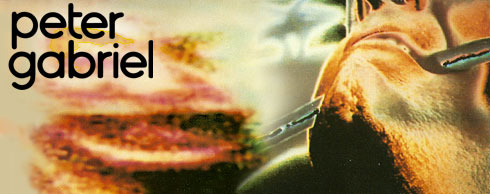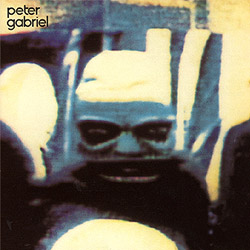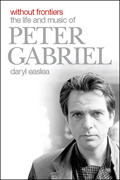


With PG III (aka Melt) Peter Gabriel had made the rhythm the starting point for his song-writing. His interest in music from all over the world provided a new core around which he would invent songs. It was from a huge collection of private recordings and recording sessions with, for example, African musicians that Gabriel developed ideas for the new album. Even 1980 he mentioned some of the songs he thought of putting on the new album. Amongst them were I Go Swimming and Milgram’s 37. The one was released as a live version only on Plays Live while the other came out on So in 1986. Gabriel also mentioned a couple of songs like Twilight Zone or Come My Way that were supposedly half-finished, but nothing was ever heard of them again. In a Melody Maker interview Gabriel explained the motto of the up-coming album: More electronics, unusual sounds, avoid the typical rockband sound particularly as far as drums are concerned.
After a long tour to promote Melt Gabriel went into the studio with producer and soundengineer David Lord to work on ideas for new songs. At this early stage Lord’s job mainly consisted of technical support for all the devices and instruments used. The Fairlight CMI was in much demand because samples could be recorded and tweaked with it. Gabriel was sick of all the established, pre-programmed sounds and drum patterns, so he deleted all presets from his drum machine and programmed new ones. He and Lord went to scrapyards to record imploding tv sets, the wind in rain gutters and all sorts of other sounds to process and use them on the album. At a time when most people were still busy trying to get the Fairlight to work or used the presets only Gabriel had already mastered the technique. One example for a new sound is the “wind in the rain gutter” sound that can be heard at the end of San Jacinto (“we will walk – on the land…”). Work on this album took up the best part of eighteen months, and it has been claimed that at one point there were several versions of eighteen songs, over seven hours of material. In the end they mixed out many bits again to return to the essence of the song. It was already then that David Lord described Peter Gabriel as a “slow worker”. – If you consider the intervals between albums now… (ten years from Us to Up) and how long it takes to release material that was recorded years ago (Big Blue Ball) it makes you wonder what David Lord would say today.
Peter Gabriel IV – released in the U.S. as “Security” – picked up the threads where III/Melt had left off and took them to the next stage. He makes extensive use of new technologies, it is present in all songs in one way or another. The world music influences that were still quotes on the previous album have here been absorbed and integrated into an idiosyncratic sound and style. Gabriel felt that this was the way to go not only for himself but for rock music as a whole: High-tech and world music would help make his music more organic and more emotional. Critics did not wholly agree, for the ubiquituous samples and loops led to some negative reviews mentioning an exaggerated love of technology.
Gabriel’s third album had been a remarkable experience for the fans because it showed an adventurous musician prepared to run musical risks. The fourth album was indicted as being too close to the mainstream. There were indeed two pop singles on Security (Shock The Monkey and I Have The Touch), but particularly that first song was anything but your average early 80s pop product.
 Peter Gabriel IV is not as gloomy as II and III, but it is a pensive album with lots of uncomfortable moments, shrill sounds and biting synthesizers. This time, however, Gabriel gets the mood swings and the dosage right. The songs are more varied, more sounds are used, which shows that Gabriel and Lord had mastered the technology and were now fully able to use it for their own purposes. San Jacinto and Shock The Monkey are still being played, and songs like The Rhythm Of The Heat, The Family And The Fishing Net or Wallflower are favourites with the fans. When Gabriel began to draw increasingly pop-oriented audiences from So onwards these songs fell behind a bit though they are the core of the album.
Peter Gabriel IV is not as gloomy as II and III, but it is a pensive album with lots of uncomfortable moments, shrill sounds and biting synthesizers. This time, however, Gabriel gets the mood swings and the dosage right. The songs are more varied, more sounds are used, which shows that Gabriel and Lord had mastered the technology and were now fully able to use it for their own purposes. San Jacinto and Shock The Monkey are still being played, and songs like The Rhythm Of The Heat, The Family And The Fishing Net or Wallflower are favourites with the fans. When Gabriel began to draw increasingly pop-oriented audiences from So onwards these songs fell behind a bit though they are the core of the album.
The Rhythm Of The Heat
A monotonous flute loop opens the album, synthesizer and samples join in – and, of course, the African drums that work themselves into a frenzy towards the end of the song. Gabriel’s voice moves from initial calm into intense incantantions. A brief pause – the song seems to be over already – then the long cry “The rhythm has my soul” triggers a percussion fireworks. The Ekome Dance Company embark on wild whirl of Ghanaian drums. We witness a ritual dance as the drums drive us inexorably into a trance. This has nothing to do anymore with rock or pop music. The lyrics are about Gabriel’s central musical discovery of the late 70s and early 80s: The rhythm that is most prominent in both words and music.
The inspiration for this song came from C.G. Jung’s essay Symbols And The Interpretation Of Dreams in which Jung mentions an incident on his journey through Eastern Africa. In 1925 Jung met a group of Bari dancers and drummers in Sudan. They performed a dance to welcome him and his company, and Jung was very impressed by the music – and deeply scared of it at the same time. Jung joined in the dance, but abruptly stopped the whole thing and urged the drummers to leave. He was afraid the music would send him into as deep a trance as the African dancers and that he would lose his self control so that “primitive instincts” would surface. Jung’s fear and fascination with the “savage in us” is represented in the maniac drumming at the end of the song. Incidentally, the working title was Jung In Africa. The Rhythm Of The Heat was used to begin Gabriel’s concerts in a spectacular way when the band would enter the venue through the audience entrance carrying (and playing) the drums.
San Jacinto
Shimmering heat, flapping wings, gleaming sun – intertwined Fairlight loops and marimba sounds give San Jacinto a flowing quality, like thoughts that keep coming back to the same topic. Vocals, subtle percussion and several samples are grouped around it. This is resolved in the line “I hold the line” and firm chords on the electric guitar. Effective, strong drumming, broad synth carpets, and always the loop from the beginning – it’s like floating across the prairie, broad horizons, a new future. The song has hypnotic qualities – Gabriel has rediscovered the very big sound to a degree, and the careful use he makes of it makes it doubly impressive.
Inspiration for this song came from an encounter Peter had with a native American, an Apache, who told him of a rite of initiation for young men. The young Apache would follow the medicine man onto a mountain (“A rattle in the old man’s sack – look at mountain top – keep climbing up”) where he had to show whether he could survive after he had let a snake bite him. This seemingly archaic ritual takes place today, as references to “Geronimo’s disco” and the “Sitting Bull steakhouse” make clear – white man’s clichés of the lives of native Americans. The fight against the snake poison (“the poison bite and darkness take my sight”) is also a metaphor for native Americans’ struggle to protect their own culture from the dominance of the white majority. A line like “I hold the line” is not only a young man encouraging himself to see the ritual through, a ritual that may have a fatal outcome, but also a call to native Americans to keep their traditions alive.
There are several places called San Jacinto in the United States; the song is located in San Jacinto, California. There is a reservation, though not for the Apaches, but the Soboba. San Jacinto is, however, not really a point on the map but a code for the decline of native Americans’ original culture.
I Have The Touch
A march rhythm, wild guitars, a merry tune and happy synth sounds – this is the most straightforward song on the album, a song about the desire for contact and closeness. I Have The Touch is simply great groovy music, a precursor, if you like, of Sledgehammer and Steam. The lyrics can be read as a sarcastic comment on modern urban life, eternal traffic jams and the dissolution of the individual in a mass of people, or as a musing of unfulfilled sexual desires. Gabriel had read studies that researched how much and how intense people would touch in different countries and found himself frustrated at the lack of bodily contact in Britain – which was an inspiration for this uptempo song. I Have The Touch was released in several remixes that are possibly even better. It was also used in several movies.
The Family And The Fishing Net
A smokey synth sound, a peculiar flute loop (borrowed from recordings of Ethiopean folklore), rich bass sounds, Gabriel’s typical marimbas and hypnotizing synth lines prepare the ground for the central epic track on the album. Though it seems inaccessible at first the melody soon worms its way into the listener’s ears. A certain menace may be the reason not everybody will find it exciting at first. This is one of Gabriel’s songs that you need to listen to repeatedly to fully appreciate their depth. It is a journey beyond the usual verse-chorus structures into the world of peculiar sounds: Both Fairlight and synthesizer as well as Tony Levin’s Chapman stick and distorted guitars provide accents for uncomfortable and at first hardly intelligible lyrics that concern, as Gabriel put it on Plays Live, “the ritual of the wedding, the ring and the finger”. When you consider this song it is hard to believe that Gabriel has a relaxed attitude towards the topic. The fishing net is cast out by the family to catch a husband or a wife for their offspring; the lyrics are full of strong sexual metaphors, but also of drastically negative imagery. The wedding rites (“vows of sacrifice”, “dance in circles” (as in the wedding waltz), “the cake is cut and passed around in little pieces”) are strangely coupled with “headless chickens” and “the lifeguards whom the winter saves”. Interpretations are not easy. The parents’ (failed) hopes, feuds between various branches of the family, whisperings about the newly-weds and expectations for the wedding night occur. The guillotine and the hands that clasp the knife – is this an argument between the newlyweds or the wedding reception going bad…? The Family And The Fishing Net is one of Peter Gabriel’s most intriguing songs – perhaps even because of the uncomfortable atmosphere and the open lyrics. The song remained in Gabriel’s live setlists until 1987 after which it was overshadowed by the hit singles.
Shock The Monkey
With this very successful single Gabriel gave an example of what is good and intelligent pop music. A striking synth riff underlies the song that received lots of airplay. The combination of various synthesizer and effect sounds together with a mixture of live drums and drum computers is particularly effective. Contrary to the usual opinion Shock The Monkey is not about animal experiments or the protection of species, though Peter Gabriel has strong feelings about these issues, but it is “a song about jealousy” (as Peter put it on the P.O.V. video). The phrase “shock the monkey” is a metaphor for arousing jealousy or for the way the love one is hurt.
Shock The Monkey went to the top in the US mainstream rock billboard charts and made #29 in the pop singles charts while reaching only #58 in the UK. This is therefore the first single with which Gabriel had more success in the United States than at home in the UK.
Lay Your Hands On Me
A mechanical drum pattern, another set of unusual samples and a sort of recitative – this is yet another Gabriel. The brooding verse touches on aspects and absurdities of modern life (“garden grill”, “plastic windows”, “washing of the dishes”) and how cold society in general and the jet set in particular have become (“cold emotion”, “watched on by the distant eyes”, “poolside laughter has a cynical bite”). The song become more upbeat (“and I sense you know me well”, “still the warmth flows through me”) and the wish to touch others mentioned in the title. The lyrics do not ask for religious touches or gestures of blessing, they ask to be touched bodily and emotionally. “The song is about trust, healing and self-sacrifice”, said Gabriel.
This is the only song in which the powerful drumming harkens back to the mighty drum sound on the previous album. They lead into an instrumental outro. Sort of instrumental, actually, the choir keeps repeating plea to “lay your hands on me”, and even if the song does not become a trance-like chant the rich drum fills and the constant repetition continue in the vein of The Rhythm Of The Heat. The instrumental part was extended very much during live shows where it was played when Gabriel did the backwards stage-dive to be carried around on the hands of the audience. A song about trust.
Wallflower
This song is the emotional peak. Soft synthie sounds introduce a piano tune (played on Gabriel’s “official piano”, the Yamaha CP-70). From the first line the lyrics hit home. The narrator describes the life of a prison inmate, and it is soon clear that this is not your usual criminal but a political prisoner suffering from particularly severe conditions in his jail. Gabriel addressed the police terror in several Latin American countries at the time. He wrote this song after he had read an Amnesty International brochure about Argentina. In an AI concert in Chile 1990 he also cited reports of torture in Chile in the 70s as an inspiration. Not only German listener may think of the interrogation scenes from The Lives Of Others when they hear the lines “they’re trying to get you crazy … they feed you scraps and they feed you lies… to lower your defences, no compromise”, but dystopias as in 1984 or Brave New World come to mind. The inhuman prison conditions are contrasted with the repeated promises by the narrator to keep supporting the prisoner and not to let him be forgotten. The song showcases the special abilities of Peter Gabriel the political artist: He does not agitate, but tries to touch people – and moves them much deeper than any political platitudes could.
Gabriel uses elements that occurred in Humdrum or Lead A Normal Life; Don’t Give Up and Washing Of The Water would become heirs to this song, though never again after Wallflower would Peter Gabriel bring up such an eminently political topic.
This would be a great way to close the album – what else could surpass this emotional intensity? But there is one more song on the album…
Kiss Of Life
Gabriel goes samba – what the heck is this? This is an unexpected stylistic surprise, particularly because it brings a harsh mood swing with it after Wallflower. Latin American impressions from the harmonies and the rhythms are replaced by hectic funk in the verse. The music of Kiss Of Life is so different from the rest of the album that it feels like an added bonus track, not like part of the regular album. Perhaps the song would have worked better at another position in the album, but as it is the end of Security is a bit peculiar and unsatisfactory. The song reached #34 in the Billboard mainstream rock charts – which was twelve positions above I Have The Touch (#46).
Peter Gabriel IV / Security is (except for perhaps the last song) a well-structured, well-balanced album. Emotional and intense songs sit next to epic pieces, a couple of uptempo songs may even tempt you to shake a leg. It is pop/rock, but frequently is art pop / art rock that does not suck up to the mainstream, catchy though the songs may be.
Most songs are about the inner life, personal relationships and lack thereof, and about man’s position in society. Wallflower is the odd one out lyrically because it is more political, but since the song also addresses the human(e) side of prison life the difference is not too big. This is the favourite record for many Gabriel fans; (art)pop, world music and experimental sounds are mixed in just the right proportion. In some places the way to So becomes dimly visible. The last of the self-titled albums, it marks the end of an era. Of course, Plays Live came out later as a kind of retrospective of these years. Though the first four albums are very different from each other they are all in all closer to each other than to So. One could say that Peter Gabriel IV resolves the attempts to find a style. The merging of world music influences and rock/pop music was continued only on Us.
Security went to #6 in the UK charts, to #28 in the U.S. charts and sold more than half a million records in America. Gabriel became known to an increasing number of people. He would become a superstar only with his next album, but in 1982 he was musician well known for intelligent new pop music that was not as predictable as most of the other music from the early 80s.
by Jan Hecker-Stampehl
translated by Martin Klinkhardt




New book about the career of Peter Gabriel.


Collaboration between Peter Gabriel and OneRepublic from 2016